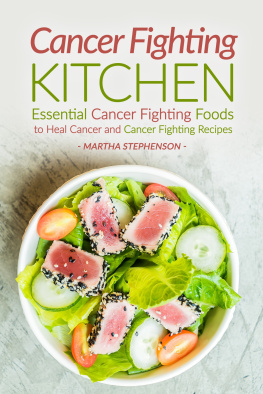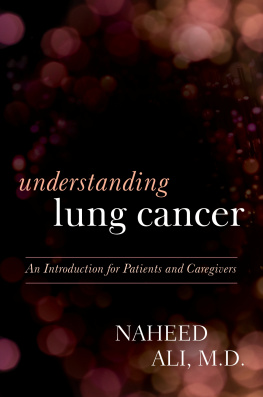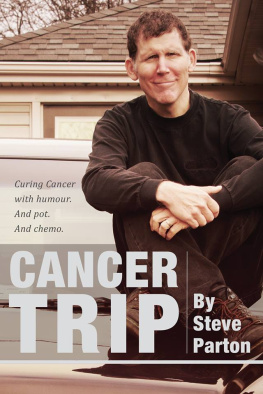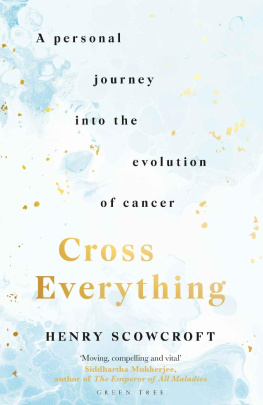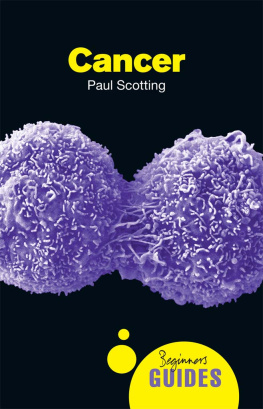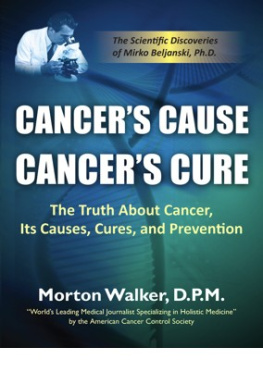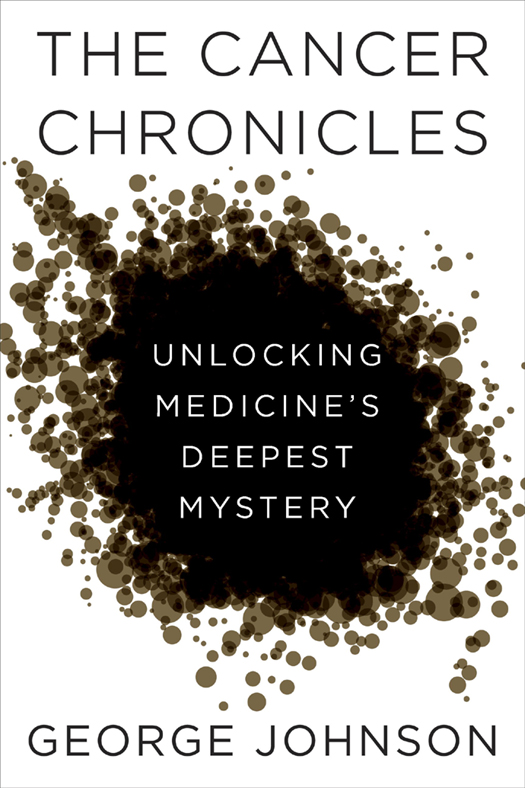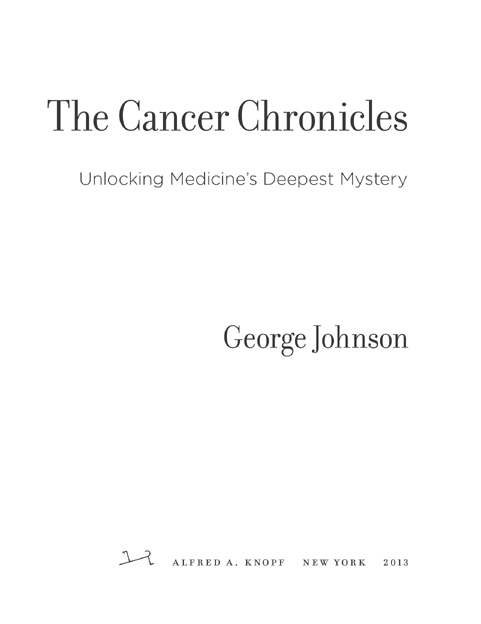All rights reserved. Published in the United States by Alfred A. Knopf, a division of Random House LLC, New York, a Penguin Random House Company, and in Canada by Random House of Canada Limited, Toronto.
Knopf, Borzoi Books, and the colophon are registered trademarks of Random House LLC.
Contents
A strange fossil from Colorado Pathology of dinosaur bones Monster tumors The epidemiology of extinction Cancer in ancient beasts Tumors in sunflowers Fish, reptiles, and amphibiansWhy Dont All Whales Have Cancer?A curious law of nature Contemplating the odds
Food pyramidology Pascals wager Folates, antioxidants, and Finnish smokers Fruits, vegetables, and giant steaks Carcinogenic estrogen The real risks of cigarettes Emanations from the earth Cancer clusters A worrisome lump Nancys cancer
In the boneyards of Kenya Face-to-face with Kanam manPalaeo-OncologyHippocrates and the crabs The wild beast of cancer Metastasis in a Scythian king Skeletons and mummies Visions of an ancient paradise Counting up the dead
Large and beautifully pellucid cellsMorbid juices Seeds and soil The mysteries of metastasis A horrifying precision The ebb and flow of lymph The surgeons diagnosis Weeds from outer space
Man-made mutations Funny-looking chromosomesA new kind of cellMatter that comes alive The Radium Girls Coal tar and tumors Viral invaders Oncogenes and tumor suppressors Cellular suicide Intimations of immortality A conspiracy of cells
Embryos and tumors Snail, slug, and twist Sonic hedgehog the Pokmon gene Cyclopean sheep Holoprosencephaly 1 + 1 = 3 Prayers of an agnostic An endless day at the hospital
The surprising aftermath of Love Canal What environment really meansThe Causes of CancerAn environmental turncoat The carcinogens in coffee Mitogenesis and mutagenesis Making sense of the cancer statistics A maverick presidential report
Cancer cells and magnets The penicillin of cancer A rare kind of malignancy Disheartening statisticsThe Median Isnt the MessageFlying farolitos A visit to MD Anderson Rothkos brooding chapel
A physics of cancer Epigenetic software The stem cell conundrum An enormous meeting in Orlando Espresso and angiogenesis The news from Oz.Communing with the microbiome Beyond the double helix Dancing at the Cancer Ball
Chimney sweeps and nuns A mysterious sympathyThe case of the missing carcinogens The rise and fall of vegetables A mammoth investigation The insulin-obesity connectionWounds that do not healA hundred pounds of sugar Skewing the energy equation
Flunking the radon test A ubiquitous carcinogen Down in the uranium mines Tourism at Chernobyl Hiroshima and Nagasaki Exhuming Curies grave A pocketful of radium Robot oncologists Relay for Life
A flight to Boston Stand Up to Cancer A tale of two cousins The return of the hedgehog Where weird drug names come from Waiting for super trastuzumab Orphaned cancers Biological game theory Contagious cancer
On Microwave Mountain Cell phones and brain waves Is cancer here on purpose?Physicists and oncologists Snapshots of a proteome Five crazy ideas Mitochondria and farandolae Maxwells triumphant demon
Authors Note
Several years ago, for reasons that will become clear in these pages, I was driven to learn everything I could about the science of cancer. How much could I as an outsider, a longtime science writer more com- fortable with the sharp edges of cosmology and physics, grasp of this wet, amorphous, and ever-changing terrain? I imagined the expanse before me as a boundless rain forest whose breadth and diversity could never be captured within a single book or even a single mind. I would find an opening at one of the borders and enter, cutting my own path, exploring where my curiosity leduntil I emerged years later at the other side, with a better understanding of what we know and dont know about cancer. I was in for some remarkable surprises.
Many people helped along the way. First I thank the scientists who devoted so much timesitting for interviews, answering e-mails, reviewing parts or all of the manuscript: David Agus, Arthur Aufderheide, Robert Austin, John Baron, Jos Baselga, Ron Blakey, Timothy Bromage, Dan Chure, Tom Curran, Paul Davies, Amanda Nickles Fader, William Field, Andy Futreal, Rebecca Goldin, Anne Grauer, Mel Greaves, Seymour Grufferman, Brian Henderson, Richard Hill, Daniel Hillis, Elizabeth Jacobs, Scott Kern, Robert Kruszinsky, Mitchell Lazar, Jay Lubin, David Lyden, Franziska Michor, Jeremy Nicholson, Elio Riboli, Kenneth Rothman, Bruce Rothschild, Chris Stringer, Bert Vogelstein, Robert Weinberg, Tim White, and Michael Zimmerman. In addition I consulted more than five hundred papers and books about cancer and sat in on dozens of lectures. Most of these sources are listed as references in my endnotes along with interesting information that didnt make it into the main text. George Demetri and Margaret Foti kindly allowed me to sit in on a private workshop in Boston organized by the American Association for Cancer Research. Thanks to them and the staff of AACR, including Mark Mendenhall and Jeremy Moore, who welcomed me to the organizations fascinating annual meeting in Florida. I am also grateful to the Keystone Symposia and the Society for Developmental Biology for accommodating me at some of their events.
Just as I was getting my boots wet, David Corcoran at The New York Times enthusiastically commissioned and published two of my early reports. Thanks to him and other colleaguesChristie Aschwanden, Siri Carpenter, Jennie Dusheck, Jeanne Erdmann, Dan Fagin, Louisa Gilder, Amy Harmon, Erika Check Hayden, Kendall Powell, Julie Rehmeyer, Lara Santoro, Gary Taubes, and Margaret Wertheimfor their reactions and advice on the manuscript.
Several recent alumni of the Santa Fe Science Writing Workshop read early versions, offering their good sense and expertise: April Gocha, Cristina Russo, Natalie Webb, Shannon Weiman, and Celerino Abad-Zapatero. Bonnie Lee La Madeleine and Mara Vatz helped with library research and the endless checking of facts. The manuscript was in constant flux and any errors that survive are my own. This will be the seventh book I have done with Jon Segal, my editor at Knopf, and the fourth with Will Sulkin of Jonathan Cape and Bodley Head in London. Thanks to them and their colleaguesincluding Victoria Pearson, Joey McGarvey, Meghan Houser, and Amy Ryan, a superb copyeditorand to Esther Newberg, my agent almost from the start.
Special thanks to Cormac McCarthy, who read an early version of the book, and to Jessica Reed, whose literary sensibility and encouragement were an inspiration. More than once my friend Lisa Chong read through the book sentence by sentence, page by page, helping to apply the finishing touch.


